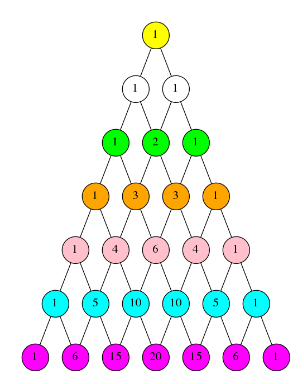5.1 KiB
5.1 KiB
- #MA284 - Discrete Mathematics
- Previous Topic: Binomial Coefficients
- Next Topic: Stars & Bars
- Relevant Slides:
-
Pascal's Triangle
- Pascal's Identity: A recurrence relation for
\binom{n}{k}:-
\binom{n}{k} = \binom{n-1}{k-1} + \binom{n-1}{k}
-
- In the previous topic, we "proved" that
\binom{n}{k} = \frac{n!}{(n-k)!k!}by countingP(n,k)in two different ways.- This is a classic example of a Combinatorial Proof, where we establish a formula by counting something in 2 different ways.

- Binomial coefficients have many important properties. Looking at their arrangement in Pascal's Triangle, we can spot some:
- (i) For all
n,\binom{n}{0} = \binom{n}{n} = 1. - (ii)
\displaystyle\sum^{n}_{i=0} \binom{n}{i}= 2^n - (iii)
\binom{n}{k} = \binom{n-1}{k-1} + \binom{n-1}{k}(Pascal's Identity). - (iv)
\binom{n}{k} = \binom{n}{n-k}
- (i) For all
- Pascal's Identity: A recurrence relation for
-
Algebraic & Combinatorial Proofs
- Proofs of identities involving Binomial Coefficients can be classified as:
- Algebraic: If they rely mainly on the formula for binomial coefficients.
-
\binom{n}{k} = \frac{n!}{k!(n-k)!} \newline \therefore \binom{n}{k} = \frac{n!}{(n-k)!(n-(n-k))!} = \frac{n!}{(n-k)!k!} = \binom{n}{k}
-
- Combinatorial: If they involve counting a set in two different ways.
- Let
Abe a set of sizen. \binom{n}{k} =number of subsets ofAof cardinalityk, but for each such subset there is a one-to-one correspondence with a subset of sizen-k.- i.e.,
\binom{n}{n-k} = \binom{n}{k},
- Let
- Algebraic: If they rely mainly on the formula for binomial coefficients.
-
Algebraic Proof of Pascal's Triangle Recurrence Relation
-
\binom{n}{k} = \frac{n!}{k!(n-k)!} \newline \newline -
\binom{n-1}{k-1} + \binom{n-1}{k} = \frac{(n-1)!}{(k-1)!(n-k)!} + \frac{(n-1)!}{k!(n-k-1)!} -
= \frac{k(n-1)!}{k(k-1)!(n-k)!} + \frac{(n-1)!(n-k)}{k!(n-k-1)!(n-k)} -
= \frac{k(n-1)!+(n-k)(n-1)!}{k!(n-k)!} -
= \frac{(n-1)!(k+n-k)}{k!(n-k)!} = \frac{n!}{k!(n-k)!} = \binom{n}{k}
-
- Proofs of identities involving Binomial Coefficients can be classified as:
-
Example:
- Let
Abe a set withnelements. - Then, the total number of subsets of
Acan be counted as follows:- Generic subset: An element is either in it or not
- For each of
nelements, there are 2 choices: in or not in. - By Multiplicative principle, 2 \times 2 \times ... \times 2 such subsets [2^n = |P(n)|].
- Number of subsets with:
- 0
- Let
-
How Combinatorial Proofs Work
-
Which are better: Algebraic or Combinatorial proofs?
- When we first study discrete mathematics, algebraic proofs may seem to be the easiest: they rely only using some standard formulae, and don't require any deeper insight. They are also more "familiar".
- However:
- Often, algebraic proofs are quite tricky.
- Usually, algebraic proofs give no insight as to why a fact is true.
-
Example
- We wish to show that:
-
{\binom{n}{0}}^2 + {\binom{n}{1}}^2 + {\binom{n}{2}}^2 + ... + {\binom{n}{n}}^2 = \binom{2n}{n}
-
- We note that
\binom{2n}{n}is the total number of subsets of sizenin a set with2nelements. - Let
Abe a set with2nelements, and label themA = \{a_1, a_2, ..., a_n, a_{n+1}, ..., a_{2n}\}. - Any subset of
Awithnelements haskelements from\{a_1 a_2, ..., a_n\}andn-kelements from t\{a_{n+1}, ..., a_{2n}\}wherekranges from0ton. - There are
\displaystyle \binom{n}{k} \cdot \binom{n}{n-k}ways of choosing thesenelements by the Multiplicative Principle. - So the total number of subsets with
nelements is\displaystyle\sum^n_{k=0} \binom{n}{k} \binom{n}{n-k}and noting that\displaystyle \binom{n}{n-k} = \binom{n}{k}and the results follows.
- We wish to show that:
-
Example
- Using a combinatorial argument, or otherwise, prove that
-
k\binom{n}{k} = n\binom{n-1}{k-1}
-
- Combinatorial Proof:
- Suppose we have a panel of
nplayers and we need to choose a team ofkplayer with a distinguished player (e.g., the goalkeeper). - We count how many ways we can do this.
- [A] Pick the team, then pick the goalie.
- By the Multiplicative Principle, we can pick a team of
kfromnin\binom{n}{k}ways and havekways then of choosing a keeper from this.-
= k\binom{n}{k}
-
- By the Multiplicative Principle, we can pick a team of
- [B] Pick the goalie, then pick the remainder of the team.
- We have
nchoices for the goalie. then choosek-1from then-1remaining players. - By the Multiplicative Principle we have
\displaystyle n\binom{n-1}{k-1}ways. - Result follows.
- We have
- Suppose we have a panel of
- Using a combinatorial argument, or otherwise, prove that
-
What is a "Combinatorial Proof" really? #card
card-last-interval:: 9.28 card-repeats:: 3 card-ease-factor:: 2.32 card-next-schedule:: 2022-11-23T22:36:16.354Z card-last-reviewed:: 2022-11-14T16:36:16.354Z card-last-score:: 5- [1] These proofs involve finding two different ways to answer the same counting question.
- [2] Then, we explain why the answer to the problem posed one way is
A. - [3] Next, we explain why the answer to the problem posed the other way is
B. - [4] Since
AandBare answers to the same question, we have shown that it must be thatA = B.
-
